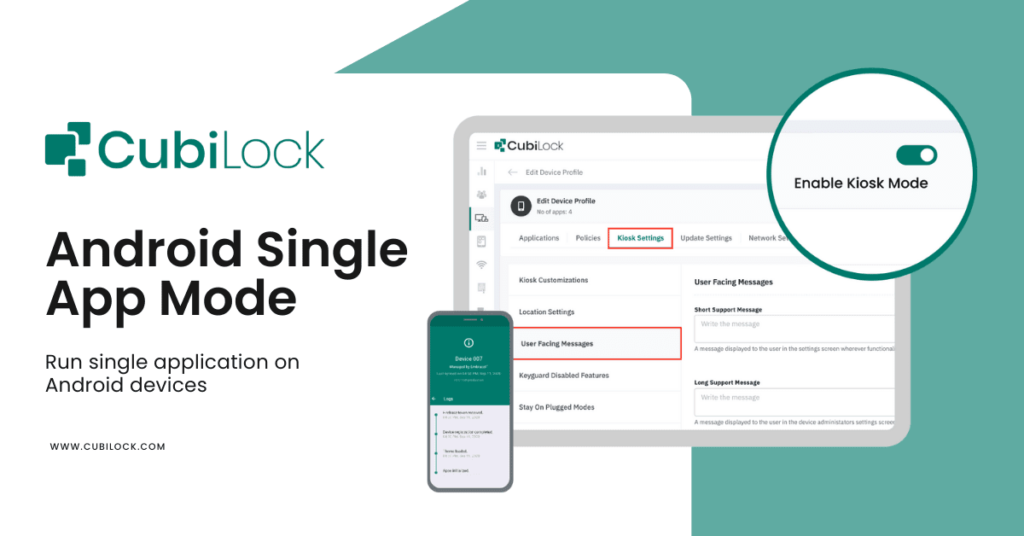In today’s digital world, mobile devices play a crucial role in both personal and business spheres. Android, being one of the most widely used mobile operating systems, offers a multitude of features and functionalities to cater to various needs. One such feature that has gained prominence in recent years is the Android Single App Mode. This feature, which restricts a device to run only a single application, offers several benefits, particularly in the business and enterprise sectors. In this article, we will delve into the advantages of Android Single App Mode and how it can enhance productivity, security, and overall user experience.

Enhance Security
One of the primary benefits of Android Single App Mode is the bolstered security it offers. By limiting a device to run only one designated application, organizations can significantly reduce the risk of data breaches, unauthorized access, and malicious software installations. This becomes especially important in sectors that handle sensitive data, such as healthcare, finance, and government agencies.
With Single App Mode, a company can enforce strict control over the application that is permitted to run, ensuring that employees or users cannot access other apps that may compromise security. This is particularly beneficial in scenarios where sensitive information, like patient records or financial data, needs to be protected. Even if a device is lost or stolen, the limited functionality minimizes the potential for data exposure.
Improve Focus and Productivity
Single App Mode can be a valuable tool for improving focus and productivity. By restricting a device to a single application, users are less likely to be distracted by unrelated apps, notifications, or other time-wasting activities. This is particularly useful in business settings, where employees need to concentrate on a specific task or application.
For example, in retail, employees can use a dedicated point-of-sale application without the temptation of checking social media or browsing the web. In manufacturing, workers can use an app to track inventory or production without getting sidetracked by other non-essential applications. This increased focus can lead to enhanced efficiency and ultimately boost productivity.
Streamline Device Management
Managing a fleet of Android devices in an enterprise setting can be a complex task. Android Single App Mode simplifies device management by allowing administrators to configure and control a device’s behavior easily. This reduces the risk of errors, ensures consistency in device usage, and simplifies the overall maintenance of a device fleet.
Administrators can remotely configure devices to run a specific application, update the application, or change the allowed application as needed. This remote management capability is particularly valuable for companies with a large number of devices distributed across various locations.
Enhance User Experience
User experience is a critical factor in the success of any application or device. Single App Mode can help improve the user experience by eliminating unnecessary complexity and distractions. When users know that a device is dedicated to a specific task, they can navigate and interact with the application more comfortably and efficiently.
For instance, a self-service kiosk in a museum or a restaurant can offer a simplified, focused experience for users. Customers can use the kiosk to browse the menu or access information without being confused by multiple apps or settings. This user-centric approach can lead to increased customer satisfaction and retention.
Increase Device Lifespan
Limiting a device to a single application can prolong its lifespan by reducing wear and tear. When a device runs a single application, it consumes fewer system resources, and background processes are minimized. This results in reduced CPU usage, memory consumption, and less frequent read/write operations on the device’s storage, all of which contribute to a longer device lifespan.
In business and industrial settings, where mobile devices are often subjected to demanding conditions, this can result in cost savings by reducing the frequency of device replacement or repairs.
Customization and Branding
Android Single App Mode allows organizations to create a highly customized and branded user experience. The application running in Single App Mode can be tailored to match the company’s branding, making it visually consistent with the organization’s image. This creates a seamless and professional look and feel for users.
Moreover, customizing the user interface can help organizations convey important messages or information to users. For example, a museum might use a custom interface to provide information about exhibits or special events, or a business might use it to display branding and marketing materials in a retail environment.
Compliance and Regulation Adherence
In many industries, compliance with regulations and standards is essential. Android Single App Mode can aid organizations in adhering to these regulations by ensuring that devices are used in a manner consistent with legal requirements. For instance, healthcare organizations can restrict mobile devices to run only approved medical apps to comply with HIPAA regulations, and financial institutions can restrict devices to secure banking apps to meet industry standards.
Additionally, Single App Mode can help with auditing and monitoring, as it provides a controlled and predictable environment for device usage. This can be invaluable when demonstrating compliance to regulatory bodies.
Energy Efficiency
Running a single application consumes fewer system resources, which, in turn, results in increased energy efficiency. Devices in Single App Mode are less likely to drain their batteries quickly compared to devices with multiple applications running in the background.
In scenarios where devices are used for extended periods, such as in healthcare or logistics, this energy efficiency can be a significant advantage. It ensures that devices remain operational for more extended periods without frequent recharging or battery replacement, reducing downtime and increasing productivity.
Conclusion
Android Single App Mode offers a range of benefits across various industries, from enhanced security and streamlined device management to improved focus, user experience, and compliance adherence. This feature provides a powerful tool for organizations seeking to optimize their mobile device usage, reduce distractions, and maintain strict control over device functionality. As technology continues to play an ever-increasing role in our daily lives and work environments, Android Single App Mode stands out as a valuable solution for optimizing mobile device usage. Its versatility and potential for customization make it a compelling option for businesses, healthcare providers, retail operations, and various other sectors seeking to make the most of their Android devices while ensuring a secure and efficient user experience.





